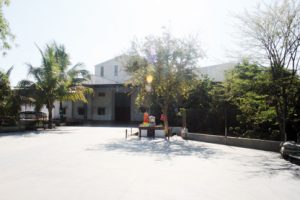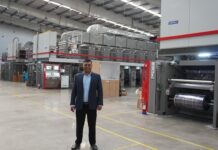Both sides of the 120-km stretch from Pune to Ahmednagar are rife with small, medium and large Indian and global manufacturers. Although the area around Pune remains the traditional industrial hub, in recent years Ahmednagar is catching up to its bigger neighbour—both in terms of quality and quantity. An example is Vardhaman Polyfilms, a 17-year-old manufacturer of multilayer plastic polyethylene films and a flexible packaging printer and converter. Vardhaman has embarked on a dramatic modernization program by signing up for a top-of-the-line Bobst F&K 20SIX 8-color CI flexo press with all the bells and whistles.
Soft-spoken and knowledgeable, Manish Munot first visited the K exhibition in Dusseldorf in 2003 where he saw an array of high-tech presses including the Bobst F&K CI flexo press, which seemed at the time the stuff of dreams for a relatively new packaging company. At the recent K event in Dusseldorf in October 2016, Vardhaman Polyfims was able to take an important step in realizing its ambitious plans as Manish signed up for a Bobst F&K 20SIX 8-color CI flexo press. The 400 m/min press will arrive in Ahmednagar in March for installation and commissioning by May 2017.
Vardhaman Polyfilms is a family-owned and managed company. One of the two key managing partners, Manish says, “Our aim is to be among the leading flexible packaging printers and convertors in the country and to achieve this ambition we are embarking on an extensive investment drive in the coming 12 months. We are opting for the best technology that is out there and the high-speed Bobst F&K CI flexo press is the first step towards achieving our goal.”
In the company’s two-acre plant situated in the Ahmednagar MIDC area, Vardhaman’s current infrastructure comprises two multilayer blown film lines, two rotogravure printing lines and two slitter rewinders while the cylinder-making is outsourced to a trade supplier. The company supplies packaging films mainly to the milk and edible oil segments. Of the current 300 ton monthly capacity, about 240 tons goes to these two consumer food segments while the balance 60 tons is supplied to the agricultural sector as well as other flexible packaging consumers.

“When the new Bobst press becomes fully operational, our focus would be to convert gravure jobs to flexo. There are many jobs in the market that can be converted and with the best technology at our disposal, we are confident of making that change. In fact, with awareness about food safety growing, the dairy industry’s leading players have already switched over to wide web CI flexo when it comes to milk packaging and now even the smaller players who pack as little as 1,000 liters a day are opting for flexographic printed films. To start with, we will target customers in a 200-km radius of our plant and explain to them the several advantages flexo technology offers, especially for food and hygiene consumer products,” says Mahesh Munot, Manish’s brother and working partner in Vardhaman Polyfilms.
Capacity expansion and new product line
Once the Bobst F&K flexo press comes in to production in May, the company’s capacity for flexible packaging materials will jump from 300 tons to approximately 700 tons each month. This will help in supplying flexible packaging to existing clients, and will allow the company to explore new product segments such as printed laminates for the baby care and personal hygiene, food and confectionery segments.
“The Bobst F&K which we have opted for is fully loaded with the smartGPS technology. This will help us to pursue and deliver to a wide variety of qualityconscious customers. Better print quality and faster printing speeds will surely lead to higher production and increased business,” says Manish. The smartGPS technology option on the Bobst F&K press helps to precisely set up all plate mounting on the print sleeves offline saving both press time and materials with a higher level of print quality. The smartGPS digital off-press impression and registration setting system allows for the fastest change-overs in the industry with all registration and impression related setup shifted from press and to the mounting stage. It eliminates the danger of over-impression and subsequent danger of damage to plates. So, the printing quality is top notch right from the word go. Owing to this technology, there is a considerable reduction in wastage of substrate, ink, labor, energy and time. The press is also capable of positioning a dot 1 micron forward or backward of each print unit for extremely precise registration and halftone color reproduction.
Ink kitchen
Apart from the plans to invest in ancillary finishing and converting equipment and machinery such as a solvent-less laminator and slitter rewinder and bag and pouch making machines, Vardhaman’s focus on sustainability includes the use of safer inks. Currently, the company buys ink from Huber and Siegwerk. While the company is conducting a survey of inks and other relavent consumables and a decision will be taken later, it is committed to setting up an ink kitchen for the CI flexo press at the Ahmednagar plant. “As already stated, we have set some very ambitious targets and to achieve these we will be focussing on all aspects of modern and sustainable flexible packaging and the ink kitchen is one of them,” Manish explains.












